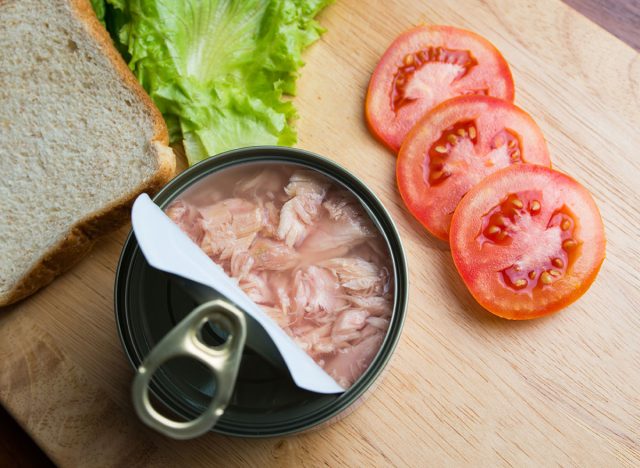Can Eating Too Much Canned Tuna Give You Mercury Poisoning?

Fish can provide you with a ton of amazing health benefits. For example, most fatty fish contains omega-3 fatty acids, which are known to help lower risk of heart disease and aid in cognitive health. The omega-3s in fish can also lower someone's risk for depression and help improve mental health. However, even though fish contains plenty of health benefits, it can also increase your exposure to mercury. In fact, according to Environmental Health Perspectives, fish consumption is to blame for over 90% of exposure to mercury in the U.S., with tuna being one of the leading fish varieties of mercury content. But even though we know tuna and other types of fish contain mercury, is it actually possible to get mercury poisoning from eating too much of it?
First, let's look at tuna's general mercury content

Consumer Reports (CR) recently released a report where they looked into the levels of mercury, a neurotoxin, contained in five different brands of tuna: Wild Planet, Bumble Bee, StarKist, Chicken of the Sea, and Safe Catch. Along with investigating the specific brands, they also looked into the different types of tuna, like albacore, light, and skipjack.
They found that all five brands contained levels of mercury in their tuna, but on average, albacore varieties across all the brands had three times more mercury than light or skipjack. But still, all varieties and brands contained some degree of mercury, and researchers from Consumer Reports were concerned that the spikes that they found in certain cans could be potentially dangerous.
Even though some varieties of tuna are known for having less mercury than others (i.e., light tuna has less than albacore on average), some cans were found with unexpected spikes in mercury. In fact, researchers found six out of the 30 cans (20%) to have these toxin spikes. With this unpredictability, experts at CR suggest that pregnant people avoid tuna completely if possible, and that other adults should consume in moderation.
"From can to can, mercury levels can spike in unpredictable ways that might jeopardize the health of a fetus," James E. Rogers, PhD, and director of Food Safety Research and Testing at CR, reportedly told CR in a report on the study.
But even with this new information about mercury levels in specific brands and types of tuna, as well as the suggestion for pregnant people to stay away entirely, there's still more to know about the average adult's risks when it comes to consuming tuna and mercury—specifically about whether or not too much tuna can actually give you mercury poisoning.
Why does tuna contain mercury?
According to Consumer Reports, you can't really consume seafood without also consuming some levels of mercury. This is because it is so ever-present in the oceans—both because it is a natural mineral but also because it comes from man-made pollution as well. Generally, larger fish are known to have higher mercury levels because they feed on smaller fish and absorb their mercury as well.
An article from Biological Trace Element Research states that not only does tuna get its mercury from feeding on other fish, but this mineral also builds up over time in the tuna's tissue because they can't easily get rid of it. This combination of factors makes mercury a big issue in tuna specifically.
What harm can mercury do to your body?

According to the EPA, mercury is considered a neurotoxin that can have negative health side effects if consumed in larger quantities—such as loss of brain cells and motor skills, worsened memory, feelings of anxiety, and an increased risk of heart disease. More specifically, methylmercury is the kind of mercury found in seafood and fish, like tuna, and high levels of this can potentially lead to poisoning.
EPA also says that symptoms of methylmercury poisoning include impairment of speech or hearing, loss of peripheral vision, muscle weakness, and a feeling of pins and needles in your body. But how can you know when to stop or how much mercury can lead to actual poisoning?
Unfortunately, there is no clear gauge for knowing how much tuna you can eat before risking mercury poisoning, especially considering how Consumer Report's new findings on canned tuna often contain unexpected and inconsistent mercury spikes. But, the FDA has some basic guidelines you can follow in order to lower your risk of poisoning.
What the FDA says
The FDA claims that adults should be fine with lower-mercury fish around once or twice a week, and that those who are pregnant or breastfeeding should limit their consumption of fish to those types with low mercury levels and keep their servings at around 4 ounces just twice or three times a week. However, it's important to remember that Consumer Reports released their new suggestion of pregnant people avoiding tuna altogether because of the inconsistency with certain cans and their levels of mercury.
If you're someone who eats a lot of tuna on a regular basis, make sure you're paying attention to some of the potential signs of mercury poisoning in the body, and talk with your doctor if you're feeling concerned about how much you consume.
Lower-mercury seafood suggestions

It's important to remember that anytime you consume seafood, you're more than likely putting some level of mercury into your body. However, there are types of fish and shellfish that contain less mercury on average than something like tuna. According to Consumer Reports, there are lower levels of mercury in things like crab, shrimp, squid, tilapia, cod, salmon, oysters, and lobster. If you're looking for canned items that you can grab and stock up on that don't have as much mercury exposure as canned tuna, try something like anchovies or sardines, both of which are considered to be in the "lower mercury" category.
Although you can't fully predict exactly how much tuna can lead to mercury poisoning, it's safe to say that higher levels of mercury can certainly have a potentially harmful impact to your health. But despite not be able to predict poisoning, you can be aware of the symptoms of mercury poisoning and try to stick to the recommended servings of fish each week to avoid too much exposure.
- Source: https://onlinelibrary.wiley.com/doi/full/10.1111/j.1365-277X.2004.00552.x
- Source: https://www.ncbi.nlm.nih.gov/pmc/articles/PMC3976923/
- Source: https://ehp.niehs.nih.gov/doi/10.1289/ehp.9377
- Source: https://www.consumerreports.org/health/food-safety/how-worried-should-you-be-about-mercury-in-your-tuna-a5041903086/
- Source: https://link.springer.com/article/10.1007/s12011-011-9136-4
- Source: https://www.epa.gov/mercury/health-effects-exposures-mercury
- Source: https://pubmed.ncbi.nlm.nih.gov/10700015/
- Source: https://www.ncbi.nlm.nih.gov/pmc/articles/PMC165591/
- Source: https://pubmed.ncbi.nlm.nih.gov/17334541/
- Source: https://pubmed.ncbi.nlm.nih.gov/7828289/
- Source: https://www.fda.gov/food/consumers/advice-about-eating-fish
- Source: https://www.fda.gov/media/102331/download









